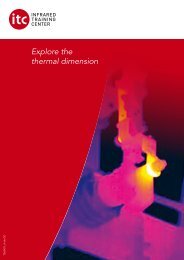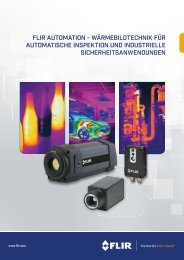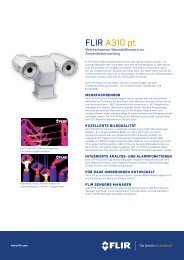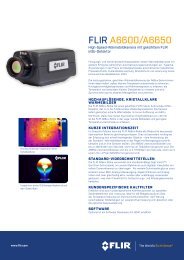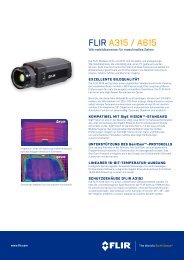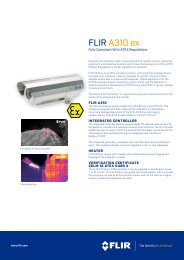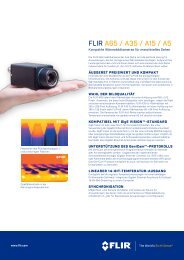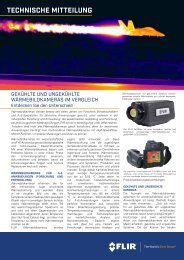Catalog Forschung und Entwicklung cooled Cameras 2013 EN
Create successful ePaper yourself
Turn your PDF publications into a flip-book with our unique Google optimized e-Paper software.
FLIR SC7000 Series<br />
Complete range of state-of-the-art<br />
infrared technology systems for<br />
R&D and thermography<br />
The FLIR SC7000 Series is a very flexible camera, with the highest sensitivity, accuracy,<br />
spatial resolution and speed.<br />
The SC7000 Series is specifically designed for academic and industrial R&D applications<br />
as well as integrators who need to have a very flexible camera, with the highest sensitivity,<br />
accuracy, spatial resolution and speed at an affordable cost. The FLIR SC7000 Series provides<br />
for the first time the CNUC & Hypercal technologies which features NUC free operation<br />
and a large dynamic range choice.<br />
removable<br />
HIGH<br />
S<strong>EN</strong>SITIVITY<br />
< 20 mK<br />
External<br />
triggering<br />
Choice of detector<br />
The FLIR SC7000 Series is available with<br />
a wide range of detectors to address any<br />
application in single and multispectral analysis.<br />
The researcher has a choice between midwave<br />
Indium Antimonide (InSb) and Mercury<br />
Cadmium Telluride (MCT) detectors. MCT<br />
detectors operating in the long-waveband are<br />
also available.<br />
Removable lens interface<br />
Gives complete flexibility in the optical path that<br />
needs to be followed for a specific application.<br />
640 x 512 pixels<br />
Some models of the SC7000 series produce crisp<br />
thermal images of 640 x 512 pixels. Users that<br />
do not need this spatial resolution can choose<br />
a version that produces thermal images of<br />
320 x 256 pixels.<br />
High Sensitivity: up to 20 mK<br />
20 mk thermal sensitivity captures the finest<br />
image details and temperature difference<br />
information<br />
External triggering<br />
External triggering allows synchronisation of the<br />
image capture to the most fleeting events. Three<br />
external analogue signals are synchronously<br />
acquired with the image allowing the embedding<br />
of external sensor measurements.<br />
INTEGRATION<br />
IRIG<br />
Adjustable integration time<br />
Integration time is adjustable in nanosecond<br />
increments. The smart external triggering feature<br />
allows synchronisation of the image capture to<br />
the most fleeting events.<br />
Removable filter wheel<br />
The FLIR SC7000 series comes standard with a<br />
removable, motorised 4 position filter wheel.<br />
This allows imaging of events in a very narrow<br />
part of the electromagnetic spectrum.<br />
Multiple video outputs<br />
The FLIR SC7000 series feature multiple<br />
independent video outputs including:<br />
• Analog – Composite (BNC)<br />
• Digital – CameraLink<br />
• Digital – Gigabit Ethernet<br />
Precise automatic IRIG time stamp of all<br />
images<br />
IRIG timing receiver is built directly into the<br />
SC7000 camera providing accurate time<br />
stamping in the camera header information. IRIG<br />
is a standardised time code allowing equipment<br />
to be synchronised to a known reference time.<br />
The most common version is IRIG-B, which<br />
encodes day of year, hour, minute, and second<br />
data on a 1 kHz carrier frequency, with an update<br />
rate of once per second.<br />
30 60 120<br />
Ultra high frame rate with windowing<br />
Depending on the model and detector, the FLIR<br />
SC7000 series can deliver thermal images up to<br />
a speed of 62,000 Hz. Windowing allows a subset<br />
of the total image to be selectively read out with<br />
user-adjustable window size at a much higher<br />
frame rate. The sub-sample window sizes and<br />
locations can be arbitrarily chosen and are easily<br />
defined using the camera control software.<br />
16<br />
Visit www.flir.com





